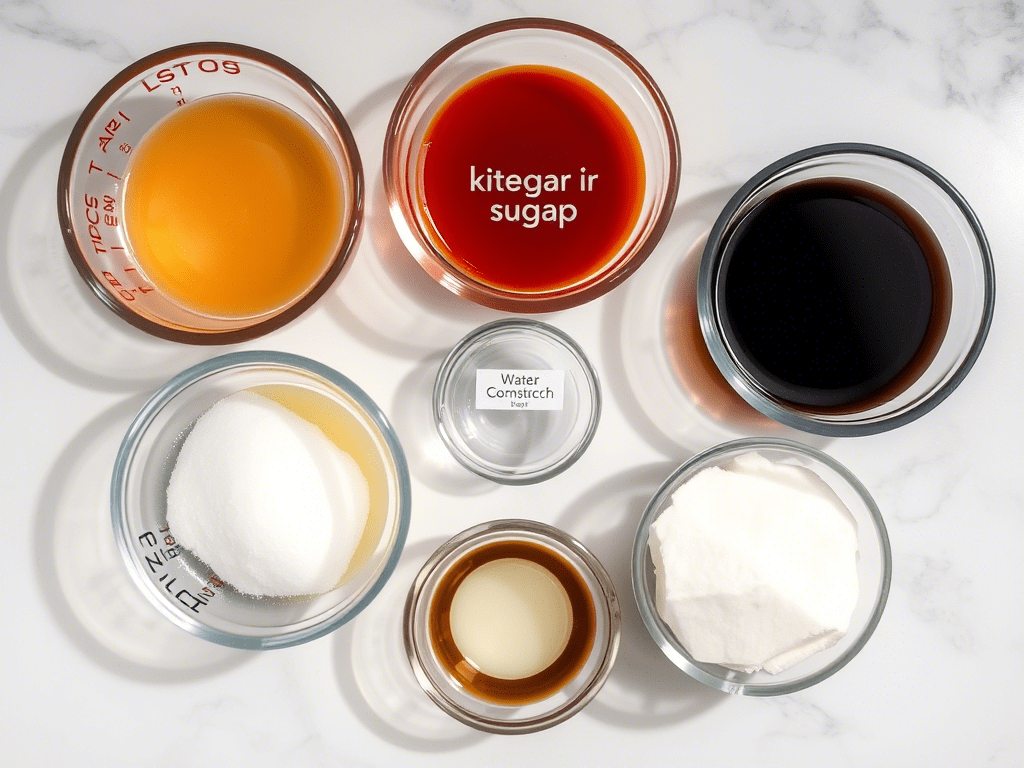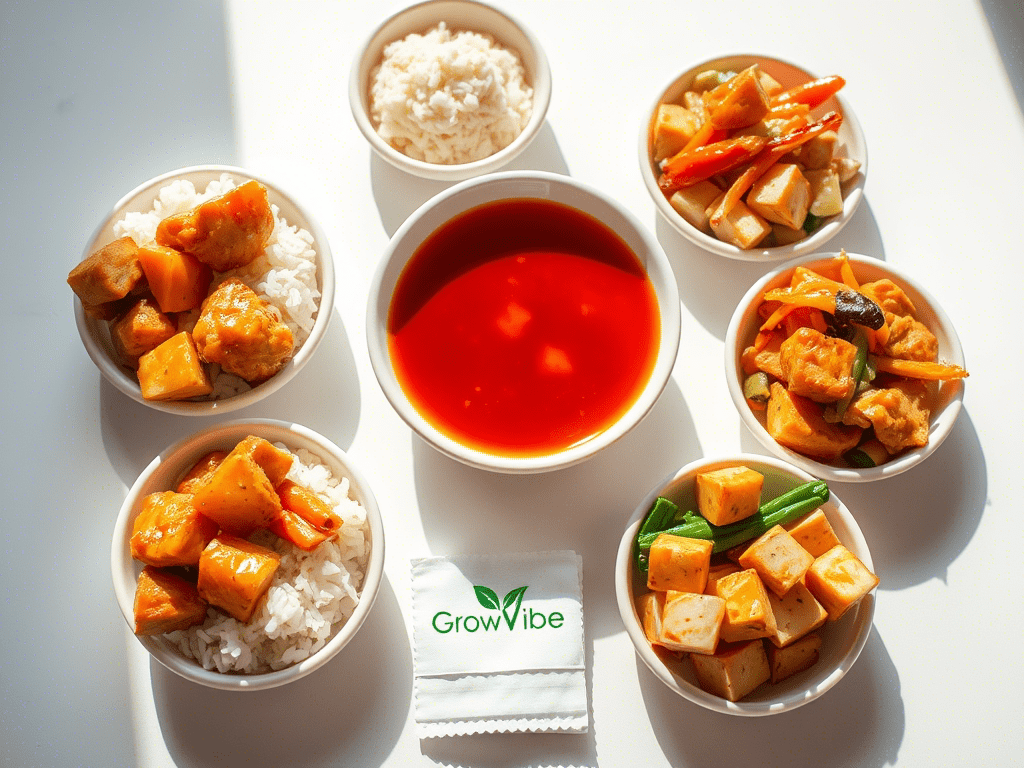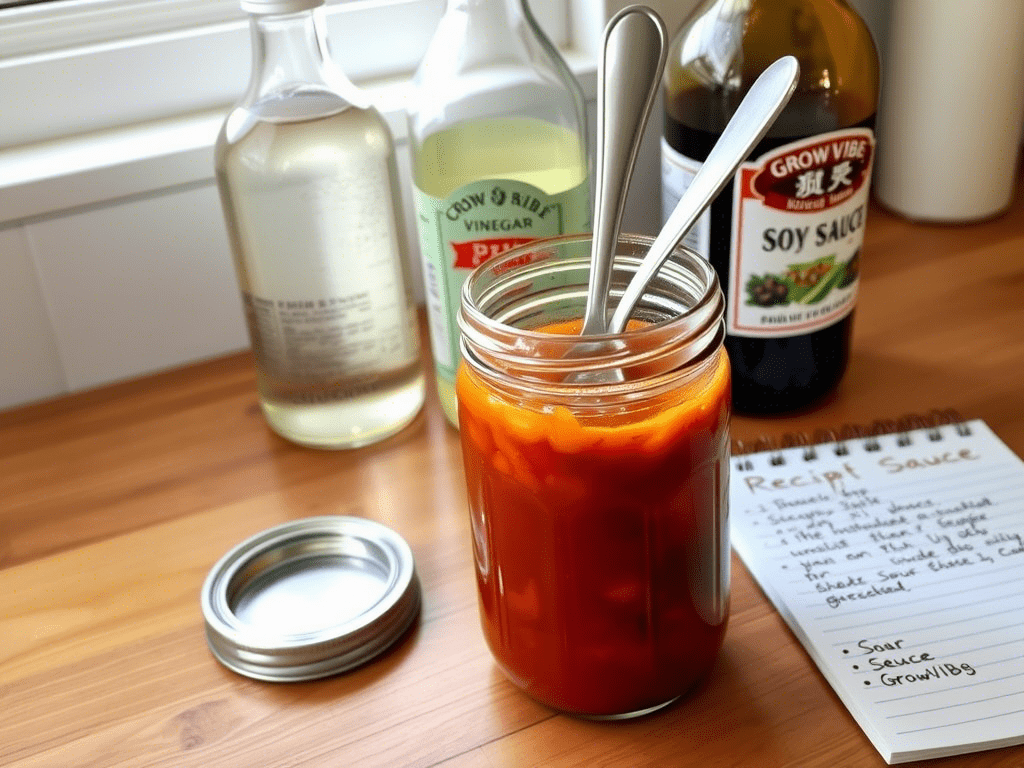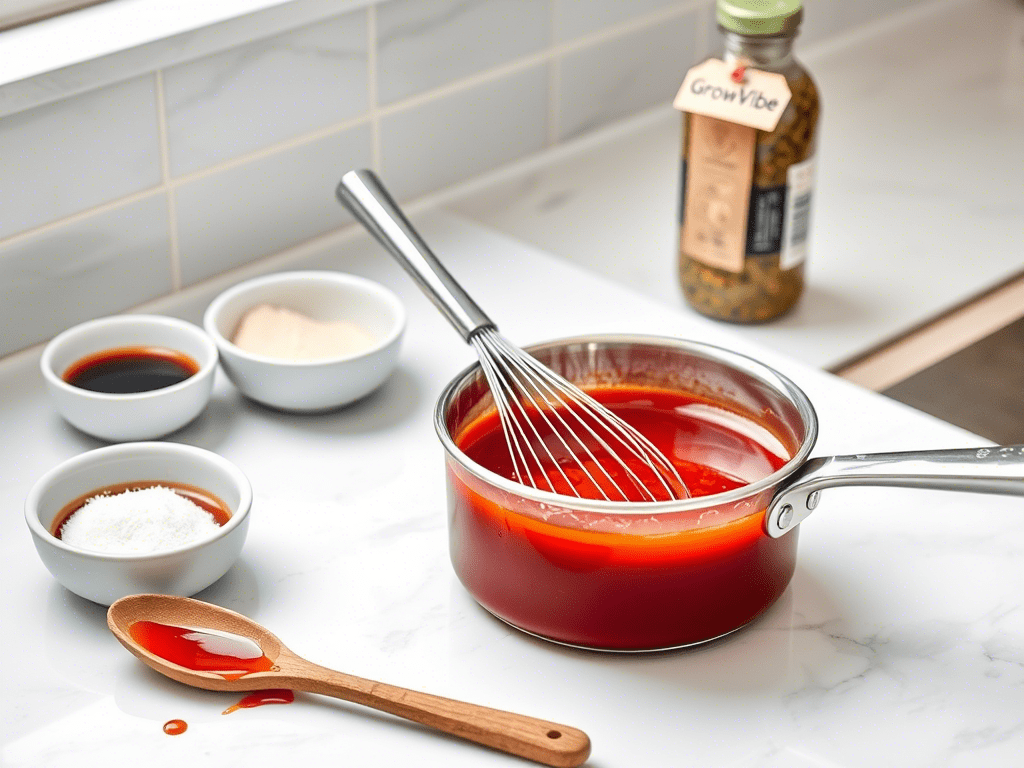5-Minute Sweet and Sour Sauce Recipe That Tastes Better Than Takeout!
There is something unforgettable about the bold, tangy flavor of sweet and sour sauce. This perfect balance between sugar and vinegar, with a touch of savory richness, makes it a staple in Chinese and Asian cuisine. If you love dipping crispy chicken, spring rolls, or even drizzling sauce over rice, this sweet and sour sauce recipe is about to become your new kitchen hero.
With just a handful of pantry ingredients and five minutes on the stove, you can create an easy sweet and sour sauce recipe that tastes fresher and more delicious than anything store-bought. No preservatives, no mystery additives. Just a simple, homemade version that delivers authentic flavor every time.
Whether you are into quick Asian dinners or want a reliable Chinese sweet and sour sauce recipe for meal prep, this version gives you flexibility and big flavor. It works beautifully as a stir-fry sauce, a glaze for meats, or a dip for snacks.
Table of Contents
Why You’ll Love This Sweet and Sour Sauce Recipe
This isn’t just any sauce. It is the kind of recipe you keep coming back to every time you crave something tangy, sweet, and a little bit bold. Here’s why this sweet and sour sauce recipe stands out from the rest:
- Fast and foolproof – It takes only five minutes from start to finish.
- Simple ingredients – You probably already have everything in your kitchen.
- Tastes better than takeout – Fresh, bold, and without all the extra additives.
- Versatile – Use it as a dip, a glaze, or in your next stir-fry.
- Customizable – Adjust sweetness, acidity, or thickness the way you like it.
Whether you’re making a quick snack or planning a full dinner, this easy sweet and sour sauce recipe is your go-to solution for big flavor with no fuss. It also pairs well with a variety of dishes, from crispy chicken bites to veggie-packed rice bowls.
Perfect for fans of Asian sweet and sour sauce and anyone who wants to elevate their meals with a homemade touch.
Ingredients You’ll Need
This sweet and sour sauce recipe keeps it simple but powerful. You do not need anything fancy to get that classic restaurant-style flavor at home. All it takes is a few pantry staples and five minutes of your time. Here is what you will need to bring this sauce to life:

- White vinegar or rice vinegar – This gives the sauce its signature tang. Rice vinegar is a bit milder and perfect for any Asian sweet and sour sauce version.
- Ketchup – Adds sweetness, color, and a smooth tomato base. It also balances the sharp vinegar beautifully.
- Soy sauce – Delivers the salty umami flavor that grounds the sauce. You can use low-sodium soy sauce if you prefer.
- Sugar – White sugar is traditional, but brown sugar adds a touch of caramel depth. Both work great in this easy sweet and sour sauce recipe.
- Cornstarch – Thickens the sauce into that glossy texture we all love. Make sure to dissolve it in water first to avoid lumps.
- Water – Helps blend all the ingredients evenly and ensures the sauce does not turn too thick too fast.
- Optional: pineapple juice – A splash of pineapple juice brings a tropical sweetness that makes this Chinese sweet and sour sauce recipe stand out.
You can also experiment with extras like fresh ginger, minced garlic, or a pinch of red pepper flakes to customize the flavor and make it your own. These small additions take your homemade sweet and sour sauce to the next level.
Equipment Needed
One of the best things about this sweet and sour sauce recipe is that you do not need any special equipment or professional setup. Everything can be done with basic kitchen tools that most people already have at home.
Here’s what you’ll need:
- Small saucepan – A good-quality saucepan helps distribute the heat evenly and prevents burning or sticking, which is especially important when working with sugar. A non-stick pan makes cleaning easier, but it is not required.
- Whisk – This is the key tool for getting a smooth, lump-free texture. You’ll need it to stir the sauce continuously while it simmers and thickens.
- Measuring cups and spoons – Precision matters in this recipe, especially with ingredients like vinegar and sugar that affect the overall balance of flavor.
- Small bowl – Perfect for mixing the cornstarch slurry before adding it to the saucepan. This prevents clumping and ensures a silky consistency.
- Heatproof spoon or spatula – Helpful for scraping the sides and bottom of the pan while the sauce cooks.
- Airtight container or glass jar – If you plan to store the sauce for later use, a sealed container will keep it fresh in the fridge.
Bonus tools if you like to get fancy:
- Fine mesh strainer – For extra-smooth sauce if you want to remove any remaining lumps.
- Squeeze bottle or pouring jug – Ideal for serving or drizzling the sauce neatly over food.
With just these tools, you’re all set to create a smooth, flavorful Asian sweet and sour sauce that’s perfect for dipping, glazing, or stir-frying.
Sweet and Sour Sauce Variations
One of the most exciting things about this sweet and sour sauce recipe is how endlessly customizable it is. Whether you’re craving a bold kick, a fruity twist, or a healthier take, these creative variations let you adapt the sauce to any dish or mood. Here’s how to make it your own:

Pineapple-Style Sweet and Sour
Add 2 to 3 tablespoons of pineapple juice for extra sweetness and a tropical layer of flavor. You can also toss in a few finely chopped pineapple chunks near the end of cooking for texture. This is especially great for Asian sweet and sour sauce fans who enjoy that fruit-forward taste with crispy chicken or pork.
Spicy Kick
Give your sauce some fire by stirring in a teaspoon of sriracha, a pinch of chili flakes, or a squirt of hot chili oil. It transforms your basic sauce into something with heat and personality. Ideal for spicy lovers who enjoy a bold contrast to sweet flavors.
Garlic and Ginger Infusion
For a more traditional Chinese sweet and sour sauce recipe, add 1 teaspoon of freshly grated ginger and 1 clove of minced garlic to the saucepan before bringing the sauce to a simmer. These aromatics add warmth and complexity that elevate even the simplest stir-fries.
Low-Sugar or Keto-Friendly
To lighten it up, replace the sugar with a natural alternative like honey, maple syrup, or coconut sugar. For keto or diabetic-friendly versions, try monk fruit sweetener or stevia. You’ll get the same tangy-sweet balance with far fewer carbs.
Tangy and Bold
Prefer it on the sour side? Add an extra teaspoon of vinegar or mix in a few drops of lemon or lime juice. This variation cuts through fried foods beautifully and brings out the sauce’s brightness. It’s a favorite for those who like their sauces sharp and punchy.
Smoky Depth
For a darker, more savory twist, mix in a small spoon of hoisin sauce, a few drops of liquid smoke, or a pinch of smoked paprika. This version goes especially well with grilled meats and roasted veggies, giving your dish a deeper, richer flavor.
Extra Gloss and Thickness
Prefer that sticky, clingy texture like restaurant sauces? Boost the cornstarch just slightly, and let the sauce simmer an extra minute. You’ll get a thick, velvety consistency that coats chicken, tofu, or veggies like a dream.
Citrus Zest Boost
Try adding a touch of orange zest or a squeeze of fresh orange juice near the end for a sweet and citrusy version. It’s a refreshing twist that’s perfect for summer dishes or lighter plates.
With all these ideas, this base sweet and sour sauce becomes a starting point for dozens of tasty possibilities. No matter how you customize it, you’ll still have a quick, flavorful sauce that outshines anything store-bought.
Serving Suggestions
This sweet and sour sauce recipe is more than just a dip — it’s a flavor powerhouse that can transform everyday dishes into something truly crave-worthy. Whether you’re planning a quick lunch or hosting a dinner with friends, here are some tasty ways to enjoy it:

Dip It
- Serve as a dipping sauce with crispy chicken nuggets, egg rolls, or fried shrimp.
- Use it as a crowd-pleaser on snack trays with vegetable spring rolls, air fryer tofu bites, or even french fries for a sweet-savory twist.
Drizzle It
- Drizzle over steamed jasmine rice, fried rice, or vegetable stir-fry bowls to add a pop of flavor.
- Spoon it over grilled chicken, pork chops, or roasted cauliflower for an instant upgrade.
Toss It
- Use as a glaze by tossing it with crispy air fryer chicken, tempura shrimp, or tofu cubes. It sticks beautifully and brings that signature sticky texture you love from takeout.
Cook With It
- Stir into a pan of sautéed bell peppers, onions, and protein (like pork, chicken, or tofu) for a full Asian sweet and sour dish.
- Add it at the end of cooking to coat noodles or veggie stir-fries.
Meal Prep Tip
Keep a jar in the fridge and use it to elevate leftovers. Even plain rice and leftover veggies turn into a satisfying meal when topped with this flavorful easy sweet and sour sauce.
This sauce plays well with many textures — from crispy to creamy — and its balance of flavors makes it incredibly versatile across cuisines, especially in Chinese and Asian-inspired meals.
Serving Suggestions
This sweet and sour sauce recipe is more than just a dip. It is a flavor booster that turns simple meals into something special. Whether you are prepping a quick bite or planning a full dinner, here are the best ways to use it.
Dip It
Use it as a dipping sauce with crispy chicken nuggets, egg rolls, fried shrimp, or even air fryer tofu. It also pairs well with fries and vegetable spring rolls for a sweet and tangy twist.
Drizzle It
Pour it over steamed rice, fried rice, or stir-fried vegetables to add extra flavor. It is also great on grilled chicken, baked pork chops, or roasted cauliflower.
Toss It
Coat crispy chicken, tempura shrimp, or tofu cubes with the sauce after cooking. It gives a glossy finish and brings out a deep, balanced taste that feels just like restaurant-style meals.
Cook With It
Add it during the last few minutes of stir-frying meats and vegetables. You can use it in noodle dishes or as a finishing sauce for rice bowls.
Meal Prep Friendly
Store it in the fridge and use it throughout the week. A spoonful of this easy sweet and sour sauce can bring life to leftovers and make quick meals taste exciting again.
This sauce blends beautifully with crispy textures and soft grains. Its sweet, tangy, and savory notes match a variety of dishes, especially those inspired by Asian and Chinese cooking.
Storage Tips
One of the best things about this sweet and sour sauce recipe is how well it stores. Whether you’re making a small batch or doubling it for future meals, you can keep this sauce fresh and flavorful with just a little planning.
In the Fridge
Let the sauce cool completely at room temperature before placing it in an airtight container or clean glass jar. In the refrigerator, it stays fresh for up to 7 days. The texture may thicken slightly as it chills, which is totally normal. Just give it a good stir or warm it gently to bring it back to its original consistency.
For best results, store it in smaller portions, especially if you plan to use it across several meals. This helps maintain freshness and prevents repeated reheating.
In the Freezer
This easy sweet and sour sauce recipe freezes surprisingly well. After cooling, pour it into a freezer-safe container, silicone mold, or ice cube tray. Once frozen solid, transfer the cubes to a sealed freezer bag. This method lets you grab just the amount you need, without defrosting the entire batch.
Frozen sweet and sour sauce keeps for about 2 to 3 months. For best quality, label your container with the date. Thaw it overnight in the fridge or heat it gently over low heat.
Reheating and Refreshing
When ready to use, reheat the sauce slowly in a small saucepan. If it becomes too thick, add a splash of water or pineapple juice to bring back its silky texture. A quick whisk is all you need to restore its smooth finish.
You can also microwave it in short intervals, stirring between each round, but stovetop reheating gives you better control.
Keeping a batch of this Asian sweet and sour sauce on hand is a game changer. It lets you skip the store-bought jars that often contain preservatives and added sugars. Plus, having a homemade version ready means you can quickly turn simple ingredients into flavorful meals.
Whether you use it for dipping, cooking, or glazing, this sweet and sour sauce recipe holds up beautifully and brings instant flavor to your favorite dishes whenever you need it.
Common Mistakes to Avoid
Even though this sweet and sour sauce recipe is simple, a few small missteps can affect the texture or flavor. Avoid these common mistakes to get that perfect balance every time.
Using the Wrong Vinegar
Not all vinegars are created equal. White vinegar gives you that sharp kick, but if you want something smoother, rice vinegar is the best choice. Avoid using apple cider vinegar unless you want a fruity twist, which might not suit all dishes.
Skipping the Cornstarch Slurry Step
Adding cornstarch directly to the hot sauce without dissolving it in cold water first is a recipe for lumps. Always mix cornstarch with water in a separate bowl before adding it to the saucepan. This is key to achieving that smooth, glossy texture every sweet and sour sauce should have.
Overcooking the Sauce
Once you add the slurry, the sauce thickens quickly. If you let it boil too long, it may become overly thick or even start to burn. Keep the heat at medium and stir constantly. As soon as it reaches the right consistency, remove it from the heat.
Not Tasting Before Serving
Each brand of soy sauce, vinegar, or ketchup can taste slightly different. Before you serve the sauce, give it a quick taste. You might need to adjust the sugar or vinegar to get the perfect balance that makes this sweet and sour sauce recipe shine.
Storing It While Hot
Always let the sauce cool down before sealing it in a container. If you store it while hot, the steam can create condensation inside the jar, leading to watery sauce or shorter shelf life.
By avoiding these simple but common mistakes, your homemade Asian sweet and sour sauce will turn out just right. Smooth, flavorful, and ready to upgrade any meal.
Healthier Swaps and Cooking Tips
This sweet and sour sauce recipe is already quick and simple, but with a few smart tweaks, you can make it healthier without sacrificing flavor. Whether you’re cutting back on sugar, watching your sodium, or just want a cleaner version, these ideas have you covered.
Healthier Sweeteners
Instead of using white sugar, try one of these natural or lower-calorie options:
- Honey – Adds sweetness with a mild floral flavor.
- Maple syrup – Brings a deeper, slightly earthy taste.
- Coconut sugar – Lower glycemic index and adds a caramel-like tone.
- Stevia or monk fruit – Great zero-calorie options if you’re looking for a low-sugar sweet and sour sauce.
Always taste as you go when using alternative sweeteners, since some are more concentrated than sugar.
Low-Sodium Adjustments
If you are reducing salt in your diet, switch to low-sodium soy sauce or coconut aminos. These give you the same savory kick with much less sodium. It’s a simple change that makes this Asian sweet and sour sauce more heart-friendly.
Add Fresh Ingredients
Enhance the flavor and nutrition with fresh add-ins:
- Grated ginger for digestion and warmth
- Minced garlic for bold flavor and immune support
- Chopped scallions or a sprinkle of sesame seeds at the end for texture
Make It Gluten-Free
This sweet and sour sauce recipe is naturally gluten-free if you use tamari or certified gluten-free soy sauce. Always double-check labels if cooking for someone with celiac or gluten sensitivity.
Lighten the Texture
Prefer a thinner sauce? Simply reduce the cornstarch by half. If you want a thicker glaze for coating meats, keep the full amount or add a little extra. It’s all about adjusting the sauce to fit your dish.
With just a few smart swaps and additions, this already simple sweet and sour sauce becomes even more versatile. Healthy cooking doesn’t have to be boring, especially when you’ve got this kind of flavor on hand.
Best Dishes to Pair It With
This sweet and sour sauce recipe is incredibly flexible and pairs well with a variety of dishes, from appetizers to main courses. Whether you’re cooking meat, vegetables, or plant-based proteins, this sauce adds the perfect finishing touch.
Chicken Dishes
- Toss with crispy air fryer chicken bites for a homemade takeout feel.
- Use it as a glaze for baked chicken wings, grilled chicken skewers, or pan-seared chicken breasts.
- It also works perfectly with shredded chicken in rice bowls or wraps.
Pork and Beef
- Brush the sauce over pork chops, meatballs, or steak bites before finishing them in the oven.
- Stir-fry thin slices of beef with peppers and onions, then coat with this rich sweet and sour sauce for a quick Asian-style dinner.
Seafood Options
- Drizzle over shrimp stir-fry or toss with fried fish for a crispy, tangy twist.
- It’s also amazing with grilled salmon as a finishing glaze.
Plant-Based Ideas
- Pair it with tofu, tempeh, or cauliflower for a hearty vegetarian option.
- Try it with steamed or roasted vegetables like broccoli, carrots, or bell peppers.
Rice and Noodle Dishes
- Pour this easy sweet and sour sauce over fried rice, white rice, or noodles to elevate the flavor instantly.
- Add it to noodle bowls with crunchy veggies and your protein of choice for a balanced meal.
This sauce brings out the best in both simple and complex dishes. It’s sweet, tangy, and savory all at once, making it a go-to condiment for meals that need a little extra flair.
FAQ (Frequently Asked Questions)
Can I make this sweet and sour sauce recipe ahead of time?
Yes, absolutely. This sweet and sour sauce recipe is perfect for meal prep. Store it in an airtight container in the fridge for up to one week, or freeze it in small portions for up to three months. Reheat it gently and stir well before serving.
Is this sweet and sour sauce gluten-free?
It can be. Use tamari or a certified gluten-free soy sauce instead of regular soy sauce to make this a gluten-free version of your favorite Asian sweet and sour sauce. Always double-check ingredient labels if cooking for someone with allergies.
Can I adjust the sweetness or sourness?
Yes. You can reduce or increase the sugar and vinegar based on your taste. Some like it more tangy, others prefer a sweeter version. That is the beauty of a homemade easy sweet and sour sauce recipe – you control the flavor.
What protein works best with this sweet and sour sauce?
This sauce pairs perfectly with chicken, pork, shrimp, tofu, and even beef. It’s also great with veggies and rice. Whether you’re cooking meat or going plant-based, this sweet and sour sauce adds bold flavor.
Can I use this sauce for stir-fries?
Definitely. This Chinese sweet and sour sauce recipe is ideal for stir-fries. Add it at the end of cooking and toss it with your ingredients to create a quick, flavorful meal.
What if my sauce turns out too thick or too thin?
If it’s too thick, add a small splash of water or pineapple juice and whisk until smooth. If it’s too thin, return it to the stove and simmer for another minute. You can also add a bit more cornstarch slurry to thicken it further.
Final Thoughts, Recipes to Try Next, and Kitchen Tools You’ll Love
If you’ve been searching for the ultimate sweet and sour sauce recipe, this one delivers all the flavor you love in just minutes. It’s tangy, sweet, savory, and perfectly balanced—exactly what you want in a homemade sauce that rivals your favorite takeout spot.
This easy sweet and sour sauce recipe gives you complete control over ingredients, texture, and taste. Whether you’re craving classic Chinese takeout flavors or trying to add more variety to your home cooking, this versatile sauce is a game changer. It works beautifully in everything from stir-fries and glazes to dipping sauces and marinades.
Once you make this Asian sweet and sour sauce from scratch, you’ll never go back to store-bought versions again.

Recipes to Try Next
- Craving a crunchy bite? Check out our Air Fryer Chicken Bites—the perfect match for this sauce.
- Want a healthy dinner idea? Drizzle the sauce over our colorful Protein Bowl Recipes for a fast and healthy weeknight meal.
- In the mood for more Asian inspiration? Our Simple Teriyaki Sauce Recipe is another must-try.skinnytaste.comallrecipes.com
Kitchen Essentials for Perfect Homemade Sauces
OXO Good Grips 8 Cup Smart Seal Glass Rectangle Container
Great for storing leftovers; leak-proof and freezer-safe.
Marukan Seasoned Gourmet Rice Vinegar, 12 oz
A versatile vinegar that’s perfect for adding authentic Asian flavor to your dishes.
Kikkoman Less Sodium Soy Sauce, 10 oz
This soy sauce offers the rich taste of traditional soy sauce with 43% less sodium.
Argo 100% Pure Corn Starch, 16 oz
Ideal for thickening sauces and gravies without altering flavor.
Cuisinart 3-Quart Stainless Steel Saucepan with Cover
A durable saucepan perfect for preparing sauces and soups.
If you’d like, I can also help you select high-quality images to complement each section of your article. Just let me know!






